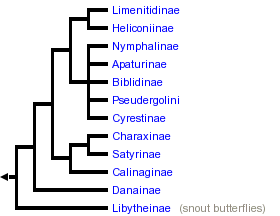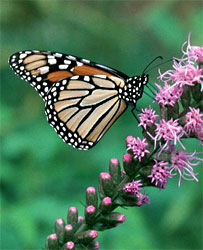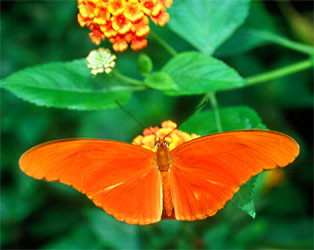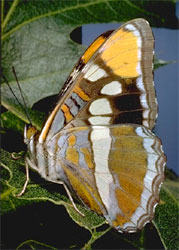Nymphalidae
Niklas Wahlberg


This tree diagram shows the relationships between several groups of organisms.
The root of the current tree connects the organisms featured in this tree to their containing group and the rest of the Tree of Life. The basal branching point in the tree represents the ancestor of the other groups in the tree. This ancestor diversified over time into several descendent subgroups, which are represented as internal nodes and terminal taxa to the right.

You can click on the root to travel down the Tree of Life all the way to the root of all Life, and you can click on the names of descendent subgroups to travel up the Tree of Life all the way to individual species.
For more information on ToL tree formatting, please see Interpreting the Tree or Classification. To learn more about phylogenetic trees, please visit our Phylogenetic Biology pages.
close boxThe pages under Nymphalidae on the Tree of Life Web site are being worked on at this moment. Relationships are shown for the most part down to the level of genera, but there is still very little other information on the pages. The pages will be continuously updated, so please check back often.
Introduction
The family Nymphalidae is the most speciose family of butterflies with about 6000 described species so far. The family contains many well-known species, such as the monarch, the Painted Lady, the buckeye, the fritillaries, checkerspots and the electric blue morphos. Indeed, nymphalids are in many places the most visible members of the local butterfly fauna. Due to their visibility and ease of study in the field and lab, many species of nymphalids have been used as model systems to understand the complexity of life on this planet.
Characteristics
All species of Nymphalidae are united by a single morphological character, the tricarinate ridges found on the adult butterfly's antennae.
Discussion of Phylogenetic Relationships
The diversity in form and life style has meant that the phylogenetic relationships of nymphalids have been contentious. This in turn has meant that there has been no consensus on the classification of the group, with some authors splitting the family into up to 9 different families! The lack of a good phylogenetic hypothesis has also meant that the evolutionary history of the group has been shrouded in mystery. Recent molecular and morphological work is bringing light to the question of how different species and groups of species are related to each other. The phylogeny shown above is the best estimate of subfamilial relationships based on as yet unpublished combined analyses of morphological and molecular data.
References
Ackery, P. R., R. de Jong, and R. I. Vane-Wright. 1999. The butterflies: Hedyloidea, Hesperioidea, and Papilionoidea. Pages 264-300 in: Lepidoptera: Moths and Butterflies. 1. Evolution, Systematics, and Biogeography. Handbook of Zoology Vol. IV, Part 35. N. P. Kristensen, ed. De Gruyter, Berlin and New York.
Brower, A. V. Z. 2000. Phylogenetic relationships among the Nymphalidae (Lepidoptera), inferred from partial sequences of the wingless gene. Proceedings of the Royal Society of London Series B Biological Sciences 267:1201-1211.
Freitas, A. V. L. and K. S. Brown. 2004. Phylogeny of the Nymphalidae (Lepidoptera). Systematic Biology 53 (3):363-383.
Wahlberg, N., E. Weingartner, and S. Nylin. 2003. Towards a better understanding of the higher systematics of Nymphalidae (Lepidoptera: Papilionoidea). Molecular Phylogenetics and Evolution 28:473-484.
Information on the Internet
Niklas Wahlberg's Nymphalidae ResearchTitle Illustrations

| Scientific Name | Danaus plexippus (Danainae) |
|---|---|
| Comments | Monarch butterfly |
| Acknowledgements | courtesy InsectImages.org (#1226333) |
| Specimen Condition | Live Specimen |
| Copyright | © Jerry A. Payne, USDA ARS |
| Scientific Name | Dryas julia (Heliconiinae) |
|---|---|
| Location | National Zoo (Washington, D.C.) |
| Comments | Orange Julia butterfly |
| Acknowledgements | courtesy CalPhotos |
| Specimen Condition | Live Specimen |
| Copyright | © 2002 |
| Scientific Name | Adelpha bredowii (Nymphalinae) |
|---|---|
| Location | Castlerock Park, Skyline (Santa Cruz County, California, USA) |
| Comments | California sister butterfly |
| Creator | Photograph by T. W. Davies |
| Acknowledgements | courtesy CalPhotos |
| Specimen Condition | Live Specimen |
| Copyright |
© 1999

|
About This Page
Niklas Wahlberg

Stockholm University, Stockholm, Sweden
Correspondence regarding this page should be directed to Niklas Wahlberg at
Page copyright © 2003 Niklas Wahlberg
- Content changed 25 September 2006
Citing this page:
Wahlberg, Niklas. 2006. Nymphalidae. Version 25 September 2006 (under construction). http://tolweb.org/Nymphalidae/12172/2006.09.25 in The Tree of Life Web Project, http://tolweb.org/











 Go to quick links
Go to quick search
Go to navigation for this section of the ToL site
Go to detailed links for the ToL site
Go to quick links
Go to quick search
Go to navigation for this section of the ToL site
Go to detailed links for the ToL site